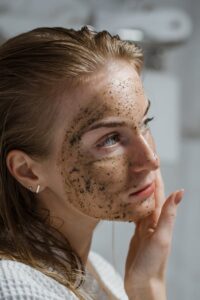Oily skincare routine
Oily skin can be frustrating to manage, especially when it leads to breakouts, enlarged pores, and a sheen throughout the day. But with the right skincare routine, you can control the excess oil while maintaining the skin’s health and hydration. Developing an effective oily skincare is key to achieving smooth, clear, and balanced skin. In this guide, we’ll explore everything you need to know about managing oily skin, including the best ingredients, skincare steps, and tips to maintain a healthy complexion.
What is Oily Skin?
skin is a type of skin that produces an excess amount of sebum (the skin’s natural oil). This condition results in a shiny, greasy appearance and can cause clogged pores, acne, and blackheads. People with oily skin often find that their complexion feels greasy shortly after washing, especially in the T-zone (forehead, nose, and chin). Oily skincare routine
Causes of Oily Skin
Several factors contribute to oily skin, including:
- Genetics: If your parents had oily skin, you’re more likely to have it as well.
- Hormonal Changes: Hormonal fluctuations during puberty, menstruation, pregnancy, or stress can trigger oil production.
- Diet: A diet high in processed foods, dairy, and sugar may exacerbate oil production.
- Environmental Factors: Humidity and hot weather can cause the skin to produce more oil.
How Oily Skin Affects Your Complexion
Excessive oil can lead to clogged pores, which can result in acne, blackheads, and whiteheads. Oily skin may also cause enlarged pores, especially around the T-zone area. The skin may also appear shiny, which can be difficult to manage throughout the day.
Benefits of Following an Oily Skin Care Routine
A well-structured skincare routine is crucial for oily skin because it helps:
- Control Excess Oil: With the right products, you can keep oil production under control.
- Prevent Acne: Regular cleansing and exfoliation can help reduce breakouts caused by clogged pores.
- Reduce Shine: A balanced routine helps eliminate that greasy shine.
- Narrow Pores: By controlling oil and removing debris, pores may appear smaller and less clogged.
Key Ingredients for Oily Skin Care
Choosing the right ingredients is essential for managing oily skin. Here are some key ingredients to look for:
- Salicylic Acid: A beta-hydroxy acid (BHA) that penetrates pores to help remove excess oil and dead skin cells, preventing clogged pores and acne.
- Niacinamide: A form of vitamin B3 that helps reduce sebum production, soothe inflammation, and minimize pores.
- Tea Tree Oil: Known for its antibacterial and anti-inflammatory properties, it helps prevent acne without irritating the skin.
- Hyaluronic Acid: While oily skin doesn’t need as much moisture, it still requires hydration. Hyaluronic acid attracts water to the skin without adding excess oil.
- Clay: Ingredients like kaolin or bentonite clay help absorb excess oil and impurities, leaving the skin feeling fresh and clean.
Steps of a Comprehensive Oily Skin Care Routine
A proper oily skincare routine consists of six main steps: cleansing, exfoliating, toning, serum application, moisturizing, and sunscreen.
Cleansing
Why Cleansing is Important:
Cleansing removes dirt, oil, and makeup from the surface of your skin. For oily skin, it’s crucial to use a gentle yet effective cleanser that doesn’t strip the skin of its natural oils. Over-cleansing can trigger more oil production.
Best Cleansers for Oily Skin:
- Gel-based or foaming cleansers are ideal because they help remove excess oil without leaving the skin dry.
- Look for products containing salicylic acid or benzoyl peroxide to help manage oil and prevent acne.
How to Cleanse:
- Cleanse twice a day (morning and night) to keep your skin free of excess oils and impurities.
- Avoid scrubbing the skin aggressively—use gentle, circular motions with your fingertips.
Exfoliating
Why Exfoliating is Crucial:

Exfoliating removes dead skin cells that can clog pores and lead to acne. People with oily skin benefit from exfoliating regularly, but it’s important not to overdo it, as too much exfoliation can damage the skin barrier.
Best Exfoliators for Oily Skin:
- Chemical exfoliants like salicylic acid (BHA) are excellent for oily skin. They penetrate pores and dissolve dead skin cells.
- Avoid physical exfoliants (scrubs) with large, rough particles, as they can irritate the skin and exacerbate oil production.
How Often to Exfoliate:
- Exfoliate 2-3 times a week, depending on your skin’s tolerance. Don’t over-exfoliate, as this can strip the skin and increase oil production.
Toning
Why Toning Helps:
Toners help to balance the skin’s pH after cleansing and remove any remaining oil or impurities. They can also tighten pores and prepare the skin for better absorption of serums and moisturizers.
Best Toners for Oily Skin:
- Alcohol-free toners with ingredients like witch hazel, niacinamide, or tea tree oil work well for oily skin types.
- Look for gentle toners, without harsh astringents that can dry out the skin.
How to Apply:
- Use a cotton pad to apply toner to your face or gently pat it on with your hands. Apply it after cleansing and before serum or moisturizer.
Serum
Why Serums Matter:
Serums are concentrated treatments that address specific skin concerns, such as excess oil, acne, and enlarged pores. For oily skin, you’ll want a serum that helps regulate oil production and prevent breakouts.
Best Serums for Oily Skin:
- Niacinamide serums help reduce oil production and inflammation.
- Salicylic acid serums can help exfoliate the skin and prevent clogged pores.
How to Apply:
- After toning, apply a few drops of serum to your face and gently pat it on the skin. Let it absorb before applying moisturizer.
Moisturizing
Yes, Oily Skin Needs Moisture:
Even though oily skin produces excess oil, it still requires hydration. Dehydrated skin can produce more oil in an attempt to compensate for the lack of moisture.
Best Moisturizers for Oily Skin:
- Oil-free gel-based moisturizers work well because they hydrate without adding more oil.
- Look for moisturizers with ingredients like hyaluronic acid, which hydrates without being heavy or greasy.
How to Apply:
- Use a pea-sized amount of moisturizer and apply it evenly to your face after the serum.
Sunscreen
Sunscreen is Non-Negotiable:
Sunscreen protects the skin from harmful UV rays, preventing premature aging and skin cancer. For oily skin, it’s essential to use a sunscreen that doesn’t clog pores or contribute to excess oil production.
Best Sunscreens for Oily Skin:
- Matte-finish sunscreens or gel-based sunscreens are perfect for oily skin, as they control shine.
- Look for oil-free and non-comedogenic
How to Apply:
- Apply sunscreen generously to your face every morning, even if you’re staying indoors.
Additional Tips for Oily Skin
- Use Oil-Free Makeup: Look for foundations and makeup products labeled as oil-free and non-comedogenic.
- Blotting Papers: Carry blotting papers to absorb excess oil throughout the day without disrupting your makeup.
- Avoid Touching Your Face: Touching your face can transfer oils and bacteria, leading to more breakouts.
Common Mistakes to Avoid in Oily Skin Care

- Over-Cleansing: Cleansing too often or using harsh cleansers can strip your skin and cause it to produce more oil in response.
- Skipping Moisturizer: Oily skin still needs hydration. Avoiding moisturizers can lead to more oil production and dryness.
- Using Harsh Products: Products with too much alcohol or abrasiveness can irritate the skin and increase oil production.
How Diet Affects Oily Skin
Diet plays a significant role in managing oily skin. A poor diet can trigger inflammation and imbalance in oil production. Here’s how diet impacts your skin:
- Foods to Avoid: Sugary foods, dairy, and processed foods can worsen oily skin and acne.
- Foods That Can Help: Omega-3-rich foods (like salmon, walnuts, and chia seeds), green tea, and leafy greens help balance oil production.
Best Products for Oily Skin (with Recommendations)
Here are some top-rated products for oily skin:
Cleansers:
CeraVe Foaming Cleanser
Neutrogena Oil-Free Acne Wash
Exfoliators:
The Ordinary Glycolic Acid 7% Toning Solution
Paula’s Choice Skin Perfecting 2% BHA Liquid Exfoliant
Toners:
Thayers Witch Hazel
Pixi Glow Tonic
Serums:
The Ordinary Niacinamide 10% + Zinc 1%
La Roche-Posay Effaclar Serum
Moisturizers:
Neutrogena Hydro Boost Water Gel
Clinique Dramatically Different Gel
Sunscreens:
EltaMD UV Clear Broad-Spectrum SPF 46
La Roche-Posay Anthelios Clear Skin SPF 60
Conclusion
Managing oily skin requires a balanced approach that controls oil without over-drying the skin. By following a proper skincare routine and using the right products, you can minimize excess oil production, reduce breakouts, and achieve a healthy, glowing complexion. Consistency is key—stick with your routine, and over time, you’ll see improvements in the health and appearance of your skin
FAQ Section
Can oily skin lead to acne?
- Yes, excess oil can clog pores and lead to acne. A consistent skincare routine can help minimize this risk.
Should I use a moisturizer if I have oily skin?
- Absolutely! Oily skin still needs moisture, but use lightweight, oil-free formulas.
How often should I exfoliate my oily skin?
- Exfoliate 2-3 times a week to remove dead skin cells and prevent clogged pores.
Can I use a clay mask for oily skin?
- Yes! Clay masks are excellent for absorbing excess oil. Use them once a week for best results.
Is it okay to skip sunscreen if I have oily skin?
- No, sunscreen is essential to protect against UV damage. Look for oil-free sunscreens designed for oily skin.
Can oily skin become dry?
- Yes, if you over-exfoliate or use harsh products, you might experience dryness. Make sure to use gentle, hydrating products to avoid this.
